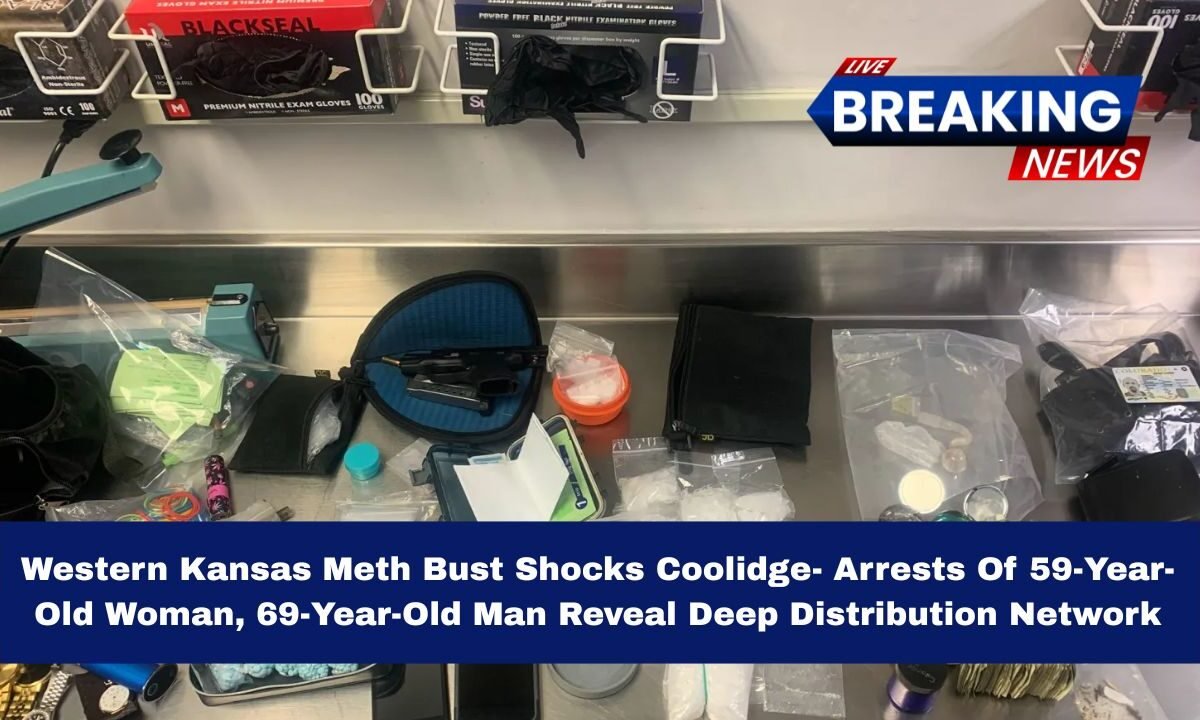A dramatic methamphetamine bust in western Kansas has culminated in the arrest of two longtime Coolidge residents, sparking questions about rural drug distribution networks and local law enforcement vigilance.
The operation, carried out by the Hamilton County Sheriff’s Office, uncovered suspected meth, paraphernalia, and evidence suggesting distribution rather than mere possession.
Below is a deep dive into the timeline, charges, evidence, suspects, local impact, and the broader implications.
Operation & Arrests: What Happened
On a Monday morning, deputies with a valid search warrant entered the address 207 N. Maple Street, Coolidge, Kansas, which was under surveillance as part of an ongoing methamphetamine distribution investigation. While executing the warrant, law enforcement seized:
- Suspected methamphetamine
- Drug paraphernalia
- Additional items consistent with controlled substance distribution
Two individuals were taken into custody:
- Patricia Apodaca, age 59, of Coolidge
- Claude Bezona, age 69, also of Coolidge
Apodaca faces multiple charges, including meth distribution, unlawful use of a communication facility in furtherance of a drug felony, possession of drug paraphernalia, and no drug tax stamp.
Bezona was arrested on possession of methamphetamine and possession of drug paraphernalia.
The severity of Apodaca’s charges suggests her alleged role was more central—coordinating or facilitating distribution or communications—while Bezona’s charges appear more limited to possession and paraphernalia.
Charges & Legal Exposure
Let’s examine the charges and what they imply:
| Person | Charges | Implication / Potential Penalties* |
|---|---|---|
| Patricia Apodaca (59) | Meth distribution; unlawful use of communication facility; possession of paraphernalia; no drug tax stamp | Facing felony-level charges, increased sentencing if convicted of distribution and communication-facilitating offenses |
| Claude Bezona (69) | Possession of meth; possession of drug paraphernalia | Misdemeanor or felony charges depending on dosage and prior offenses; lower exposure than distribution charges |
* Actual penalties depend on Kansas law, prior criminal record, drug quantity, and whether federal charges are involved.
The “unlawful use of a communication facility” charge typically means using phones, messaging apps, or other communication means to facilitate the sale or coordination of drugs—a serious enhancement.
The “no drug tax stamp” charge signals failure to comply with state-level controlled substance tax statutes (common in some states to impose a “tax stamp” regime on illicit drugs). That adds another layer of legal jeopardy.
Evidence & Investigation Details
During the search, authorities reportedly collected various items and clues indicating that the house was not merely a storage site but part of an active distribution operation. Key findings include:
- Bulk quantities of suspected methamphetamine
- Paraphernalia (scales, baggies, pipes or syringes, etc.)
- Communication devices or logs (phones, messages, call records)
- Documented distribution patterns or records
- Absence of a drug tax stamp or legitimate registration
These pieces combined suggest the location was used by the suspects to sell or facilitate sales of meth beyond personal use.
Investigations like these usually rely on surveillance, controlled buys, informants, phone intercepts, and follow-the-money techniques prior to executing the warrant. The fact that the warrant was approved means law enforcement likely presented probable cause based on evidence gathered over time.
Local & Regional Impact
- Coolidge, Kansas, a small town in Hamilton County, likely faces shock at two senior citizens allegedly running meth operations in their midst.
- Rural areas are sometimes assumed to be insulated from major trafficking, but this case underlines how distribution networks stretch into remote corners.
- The bust may boost public confidence in law enforcement and deter local distribution.
- On the other hand, questions may arise about community vigilance, reporting channels, and support for addiction treatment in the area.
Given Kansas’s history of meth challenges and cross-state trafficking routes, this arrest sends a message: no area is immune to the drug network’s reach.
Risks, Challenges & Next Steps
- Plea negotiations and defense strategies
The defendants will likely fight or negotiate, especially given the difference in charges. Defense may contest evidence chain, search warrant validity, or intent element in distribution charges. - Asset forfeiture
If convicted, the suspects may lose property, vehicles, or money tied to drug operations. - Broader investigations
This bust may be a node in a larger network. Law enforcement may trace communications to larger suppliers, intermediaries, or cross-county networks. - Community response
Local officials may push for more funding in drug prevention, awareness programs, and tighter cooperation between rural counties.
The meth bust in Coolidge, Kansas has captured attention—not only for the age of the suspects but for the gravity of the charges pointing to distribution and facilitation.
Authorities seized significant evidence indicating that the home was more than a stash location, but an operational hub. As Apodaca and Bezona face serious legal exposure, the community and region now grapple with how deep the network runs.
Regardless of outcome, this case serves as a cautionary tale: drug networks reach every corner, and vigilant law enforcement and community awareness remain essential in rooting them out.




